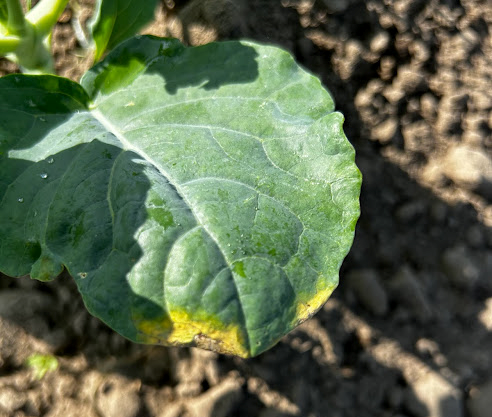Weekly Field Update
Clemson Extension agents provide updates in The South Carolina Grower this week about the status of various crops being produced throughout the state.
Coastal Region

Zack Snipes
- We have had a few chilly days in the Lowcountry with overnight lows in the low 20s.
- Many strawberry growers covered plants just to protect the crowns, as some injury can occur when temperatures are in the teens.
- Many of our leafy crops were covered with low tunnels, and crops should come out relatively unharmed. Our hardier leafy greens such as collard, kale, cabbage and others might show some damage on leaf margins. We have rain and humidity coming our way and temperatures in the 70s. These conditions plus cold damage on leaves are a perfect storm for the black rot pathogen to explode this week. Keep an eye out for this disease and harvest what you can before infection occurs.
- A few growers with citrus had a few anxious nights watching temperatures. Satsuma and mandarin type varieties should be okay with the temperatures we had, but Meyer and grapefruit are less cold tolerant. The good news is that we only had several hours at these temperatures and not several days in a row. I think most citrus will be fine.
Midlands
Phillip Carnley
- Neopestatiopsis was identified in strawberry fields in my area prior to the cold snap. Make sure to have a good rotation of chemicals on hand , specifically Thiram and Captan. Growth has been quite good with most plants in that desirable 3 to 5 crown stage. With the cold and berries being covered, be on the lookout for spider mites, especially on lower leaves that touch the plastic.
- Leafy greens are doing fair coming out of this cold with some freeze damage. Plants have a wilted look with purple tinting from phosphorus immobility due to cold soil conditions.
- Any muscadines, whether for production or table use, will need pruning and now is the opportune time. Don’t be afraid to prune harshly, and just when you think you’ve done too much, prune some more.
Rob Last
- Before the freeze event over the weekend crops were developing well.
- Pest and disease issues in crops have been minimal.
- Strawberry crown development looked good both with and without row covers. When row covers come off this week, intensive scouting will be critical to managing any issues. If there are any doubts about freeze injury and assessments, please get in touch with your local Extension agent, and we will be delighted to help.
- Brassicas and leafy greens continue to come to harvest with good quality.
- While we are in a relatively quiet time of year, it is a good opportunity to assess and review cropping plans for 2024 based on any successes and failures from 2023.
Sarah Scott
- Like everyone else, we are coming out of a very cold weekend. The temperatures have really helped us gain some chill hours for our peach crop, which is great. It is looking like we will be on track to accumulate enough chill for all our varieties here in the Ridge. We are in an El Nino season, so the extreme weather conditions are expected. We will be watching temperatures closely in the coming months, as with cold extremes also come warm snaps and late freezes.
- Our seasonal workers have started to arrive and are getting started with pruning.
- In case you missed it, back in November, the ban on use of Chlorpyrifos was overturned in court. You can check out the UGA Peach Blog post to get the updated information on use in the 2024 season.
Pee Dee
Brittney King
- A quick announcement to my Pee Dee growers and producers: the Spring Vegetable Production meeting will be held from 1 p.m. to 3 p.m. on Feb. 29 at the Pee Dee Research and Education Center (PDREC) in Florence, South Carolina. A free lunch and pesticide credits will be provided for attending! Please email me at bking7@clemson.edu or call 843-519-2402 if you are interested in attending. We have a great agenda lined up for this meeting with updates on insect, disease, and weed management in vegetable production and an introduction to the new vegetable pathology program at PDREC.
- The coldest temps in the Pee Dee these past few weeks were around 16 to 17 degrees Fahrenheit, but crops did not suffer any major damage. Some low-lying areas of fields had some issues with water buildup after the rain we had the second week in January, but that has since been resolved.
- Deer are making their mark on strawberry fields this January. When deer hunting season ended on Jan. 1, I saw previously untouched fields become nearly destroyed by deer. When the food source is no longer provided by the hunters, the deer will find the next closest thing – a strawberry field. That is why we strongly recommend ensuring deer deterrence is in place in the fall. Exclusion fencing is a successful deterrent method that many use, and the two-tiered system is perhaps even more effective and economical in deterrence. Visit this link for more information on the two-tiered fence system.
- From now until the beginning of March, it is a good time to get pruning done for small fruits like muscadines and blueberries. If you had an issue with green leaf spot (Exobasidium) in your blueberries in the fall last year, now is a good time for a dormant application of a lime-sulfur product like Sulforix. Ideally, you want to apply this product two weeks before bud break. When you are pruning blueberries, make sure to prune for an open canopy to encourage good airflow. Cultural practices like this will help prevent fungal diseases from developing or building up on your blueberry bushes.









